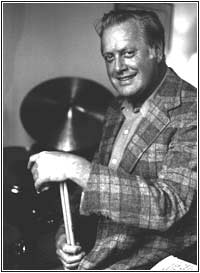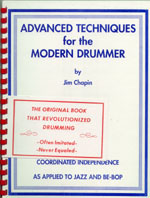By Rick Mattingly (PAS Website)

Jim Chapin |
You'll rarely see Jim Chapin without a pair of sticks and a practice pad. Part of it is his sheer love of playing; part of it comes from when his book Advanced Techniques for the Modern Drummer was first published in 1948 and he was frequently challenged to prove that the patterns and exercises in the book could actually be played.
"A lot of my inspiration came from guys who played the shuffle, like Lou Fromm, Cozy Cole, O'Neill Spencer and Arthur Herbert," Chapin says. "My approach was to start with the shuffle rhythm in the left hand and then leave notes out of it while the right hand maintained the standard swing ride-cymbal pattern. A big misconception is that the book came out of what the bebop drummers were doing, but all the exercises that showed how to play dotted-eighth/sixteenths, straight eighths, triplets and sisteenth notes against the cymbal pattern were written in 1941 - long before bebop.
"By the time I put the book out in 1948, the bebop era was in full flower, so I wrote some exercises with a lot of the phrases I heard the bop drummers playing. But those drummers didn't play independently. When they would play those phrases, they would stop the cymbal or play it in unison. All I did was notate the mechanics and show how to play those phrases while keeping the swing pattern going on the ride cymbal."

Jim Chapin |
The bop drummers were quick to take notice. "He beat a lot of drummers up with that book," says Max Roach. "We were all stumbling on it. But he made a significant contribution to conceptualizing what the drumset is all about, explaining it so clearly in his book."
For well over four decades, "the Chapin book" has been considered the definitive study on coordinated independence as applied to jazz drumming, and generations of drummers have struggled to master it. "I started studying from Advanced Techniques when I was about thirteen, and it was the first really frustrating thing I had encountered," says Dave Weckl. "That book definitely put me through changes. It was helping both my reading and my coordinated independence, and it brought me to a new level of concentration and ability. I went through it again with Ed Soph in college, and Ed had some different approaches using the same material, so it was the same thing all over again at a higher level. I always recommend that book."
Chapin stresses that his intent was never to develop technique for the sake of technique. "The idea behind the exercises was to teach independence, not that drummers should use those patterns all the time when they play," he explains. "Independence is a very appealing thing, and it's like anything else: If you have it, you want to use it. But that's not necessarily the best way to play music. Rather than overplaying, someone would be better off underplaying, like Mel Lewis did - doing something that doesn't require any technique, just a nice feel."
Chapin admits that much of his early preoccupation with developing the exercises in the book could be seen as overcompensating for not having started drumming until he was eighteen years old. "I started in the spring of 1937, and in the summer of '38 I went out with a band. I was terrible," he laughs.

Max Roach |
Several people, including Gene Krupa, suggested to Chapin that he study with Sanford Moeller. "Moeller made you play things with a continuous motion," Chapin said in a 1981 Modern Drummer article. "The motion was the message. You made the motion and the stick played it. After a while, it almost played itself.
"Moeller analyzed everything and stressed taking everything apart. If you played a paradiddle, you would learn what each hand did by itself. So from the time Moeller showed me that, I was able to think in terms of doing one thing with one hand and one thing with the other. That was the reason I got into the things that later developed into my book."
Chapin was also watching other musicians. "Pianists and organists as far back as Bach had used independence to play a line with one hand and a counter-line with the other," Chapin says. "So why did drummers have to play everything hand-to-hand?"
While Chapin was writing out independence exercises in the early 1940s, he was playing at New York's Hickory House jazz club with Flip Phillips at night. Chapin was drafted during World War II, and after he got out of the army he worked jazz gigs in Greenwich Village and with big bands at Roseland and the Acadia ballrooms. He went out with the Casa Loma orchestra for a time, and worked in Atlanta for a spell before returning to New York.
Putting the needs of his growing family (the late singer Harry Chapin was one of his sons) before his jazz career, Chapin settled into a life of teaching and playing mostly dance jobs, with an occasional jazz gig here and there. He released a Music Minus One album based on Advanced Techniques, as well as other MMO productions featuring big band, jazz, rock and combo arrangements. He also released two albums on the classic jazz label: Skin Tight, which featured big band drumming, and The Jim Chapin Sextet, which featured the group that Chapin used on Monday nights at Birdland in the mid-'50s.
In 1971 Chapin published his second book, Independence - The Open End. Innovative in design, it featured removable pages that could be superimposed over each other to create seemingly endless patterns, and it was generally agreed that one could never really "finish" the book. Expensive to produce, the book has only been published sporadically in limited quantities, and is somewhat of a collector's item.
Today, Chapin is still as enthusiastic as ever, and is a familiar sight at PAS conventions and NAMM shows where he never tires of demonstrating "the Moeller stroke" or astounding people with displays of speed and independence. Perhaps his greatest gift as a teacher is his ability to infuse students with his own excitement about drumming.
"Once you meet Jim you understand why he was ahead of his time, because he's an innovative person who has tremendous passion for his craft," says rock drummer Kenny Aronoff. "It was inevitable that he would come up with something like that book, because he had to do something with that passion."

